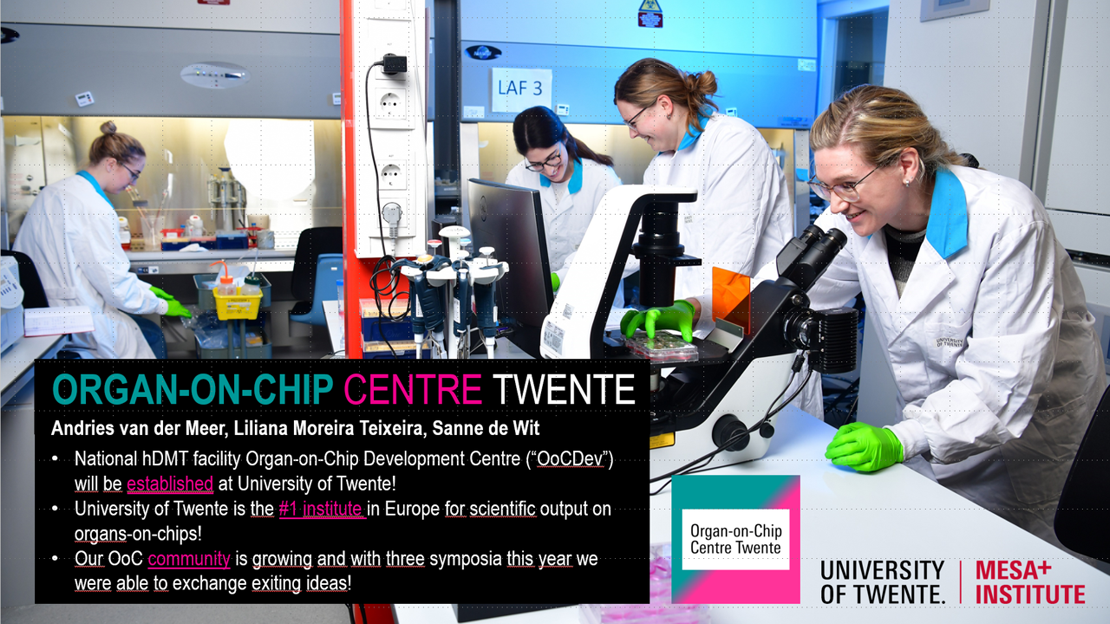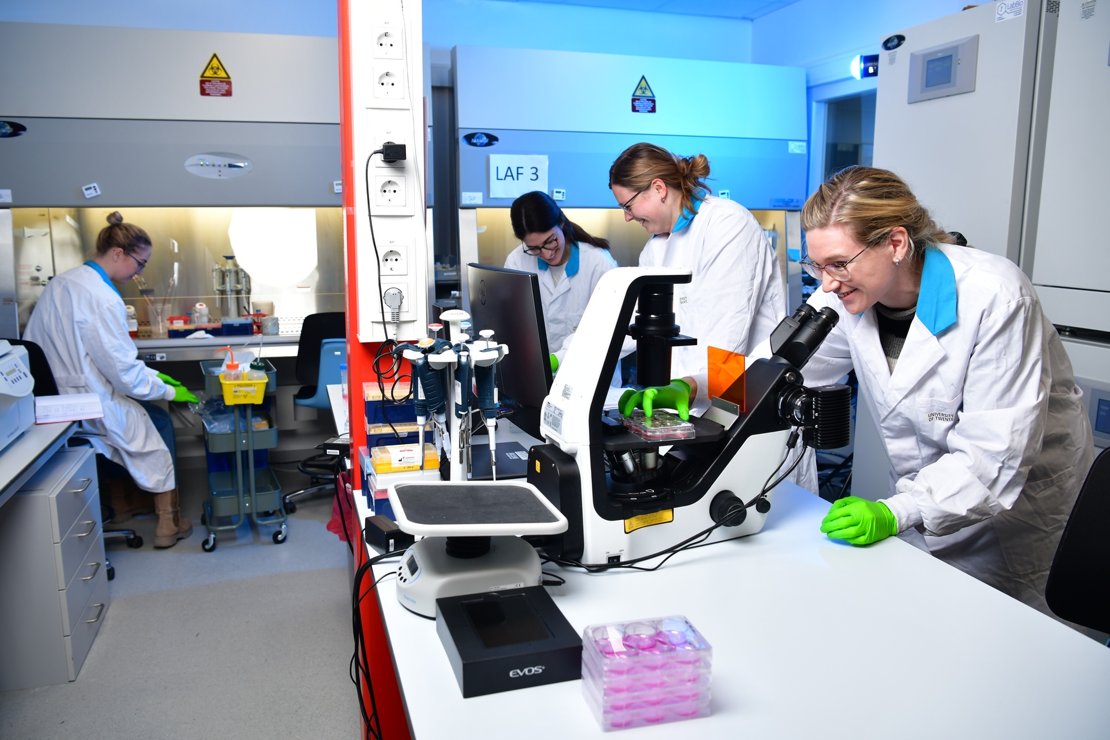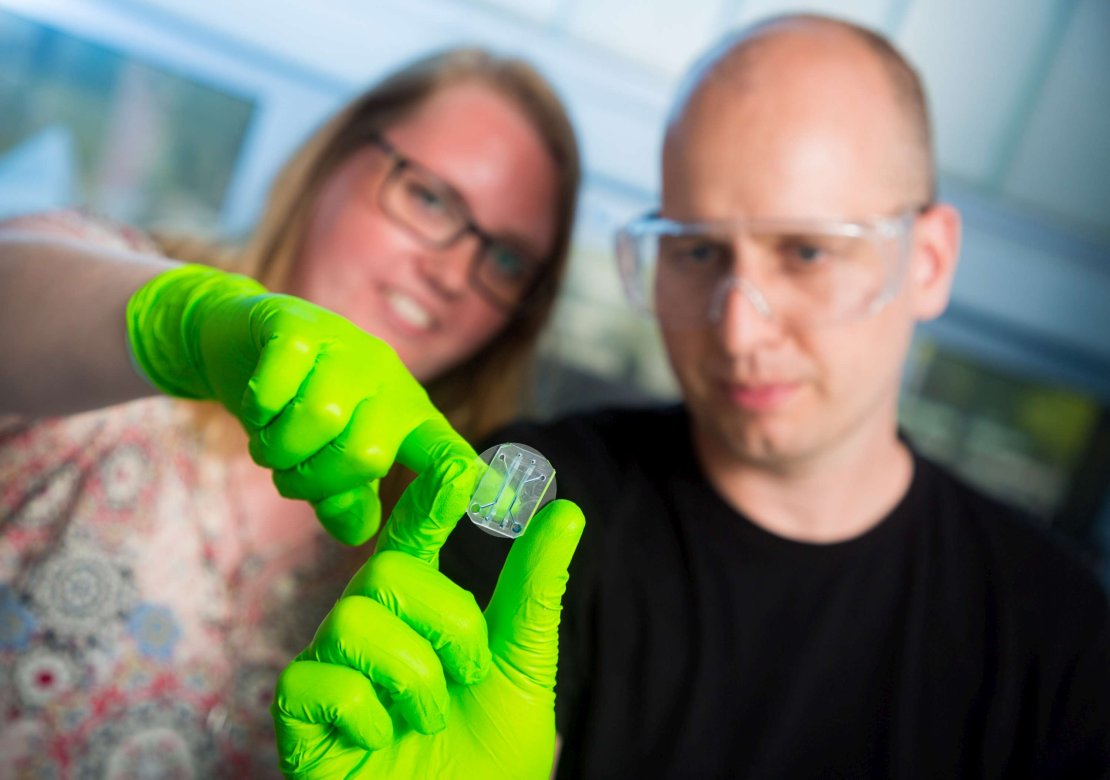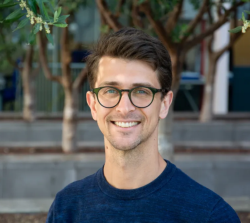At the Organ-on-Chip Centre Twente cutting-edge science meets innovation.
We are committed to advancing knowledge and pushing the boundaries of scientific discovery within the fascinating world of organ-in-chips. We do this through interdisciplinary collaboration and state-of-the-art facilities. This results in a vibrant research ecosystem that merges biology, engineering, and microfluidics where exceptional talent can thrive. Explore the highlights below to get a glimpse into the exciting world of organ-on-chip research.

PhD research projects
Our passionate PhD researchers bring fresh perspectives and expertise to our research, leading to breakthroughs.
Carla Cofiño FabrésDuring her PhD, Carla Cofiño Fabrés worked on the development of a 3D engineered heart tissue (EHT) platform that recapitulates aspects of the complex physiology of the human heart muscle. Specifically, EHT technology was combined with organ-on-chip to establish a heart-on-chip model featuring EHTs under microfluidic culture, while retaining the highly relevant readouts of the EHT-based technology. In this heart-on-chip system, she incorporated the direct interface between cardiomyocytes and endothelial cells, an interaction that plays a major role in cardiomyocyte’s function and metabolism in vivo, which could be recapitulated in this model.
Heleen Goosen-MiddelkampMore than 30% of all deaths worldwide have a vascular cause, which mostly involves heart attack or stroke caused by arterial diseases such as atherosclerosis. The exact mechanisms of early development of atherosclerosis are still unknown and need to be investigated in order to find new strategies for prevention and treatment. Organs-on-chips (OoCs) and specifically blood vessels-on-chips (BVoCs) can assist in investigating vascular diseases, by recapitulating the human vasculature more accurately than other models such as animal models. Heleen Middelkamp developed and presented multiple vessel-on-chip (VoC) models to investigate different types of vascular disease.
Aisen Gabriel de Sá VivasAnnually, around 18 million people die from cardiovascular disease. Treatment of these diseases is difficult; cardiac cells are unable to replicate. Heart-on-a-chip models can play an important role in the pre-clinical development of drugs. However, setting up cell cultures on such systems can be complex. The microscale of these devices makes the environment of the cells highly susceptible to changes. Connecting all the microfluidic tubing (microfluidic interfacing) is one of the major hurdles that all Organs-on-Chips face. For his doctoral thesis, Aisen Gabriel de Sá Vivas developed a fluidic circuit board with standard connections to connect Heart-on-a-Chip devices without tubes.
Nicole ZeijenThree-dimensional microfluidic devices can very well mimic ‘in vivo’ micro-environments as actually present in the human body. This can be done by using well-designed device architectures and combining these with clever 3-D cell networks. In her PhD research, Nicole Zeijen added a microarchitecture of pillars, providing human mesenchymal stem cells with support, to form a cellular network. The stem cells can survive for up to three weeks in these devices.
Tanja HamacherIn artificial insemination, used in the porcine and bovine industry, biosecurity and the elimination of antibiotics are important issues. ‘Microfluidic separation techniques may be more proficient in the future than macroscale separation techniques,’ Tanja Hamacher believes. ‘Here the working mechanisms are at the cellular range, using the size differences between micro-organisms and spermatozoa.’
Major research projects
OoCCT is involved in major research projects that address grand challenges and drive societal progress. These endeavours bring together brilliant minds from various disciplines. Our researchers actively engage with industry partners, policymakers, and the broader scientific community to ensure the translation of knowledge into real-world solutions.
National hDMT facility Organ-on-Chip Development Centre One of the key challenges in Organ-on-Chip (OoC) research is the complexity of new OoC model development. The field is fragmented, with many different types of OoC systems in use by public and private partners. Moreover, emerging technological innovations in microfabrication, microfluidics and sensing are difficult to implement, due to the integrated nature of OoCs. By bringing together all relevant infrastructure for OoC development in a single facility, it will be possible to achieve scientific breakthroughs.
The University of Twente has received over 3 million euros to set up a national facility for Organ-on-Chip model development that brings together our combined expertise in microfabrication, microfluidics, cell culture, bioprinting, imaging and sensing. This Organ-on-Chip Development Centre will be available to Organ-on-Chip developers and users within the Dutch consortium Human Organ and Disease Modeling Technologies via the hDMT INFRA programme. Andries van der Meer, supported by co-applicants from S&T and EEMCS faculty, has received the funding from NWO in a research infrastructure call and will lead the project.
Read more.

Organ-on-Chip (OoC) is a game-changing approach in which human cells are cultured in microfluidic chips simulating and predicting the response of healthy and diseased human tissues. It has the potential to revolutionize today’s biomedical testing procedures that often involve ethically challenged animal testing and, most importantly, lead to variable results. Despite its promise, OoC adoption is hampered by profound technical and functional limitations. In this multidisciplinary program, engineers and biomedical researchers join forces with 25 end users to overcome these limitations by developing a novel, Standardized, open and Modular OoC Approach to Recapitulate Tissues: “SMART OoC”.
Read more about this project on the website of SMART OoC.
NXTGEN HIGHTECH makes the new generation of high-tech equipment
Within six key application areas, NXTGEN HIGHTECH is working on over sixty projects with a focus on solutions. In this way, NXTGEN HIGHTECH aims to create new high-tech equipment for future generations. The government has allocated €450 million to realise this goal. Until 2030, NXTGEN HIGHTECH will invest around €1 billion. One of the project within thin National Growthfund Programme is the Organ-on-a-chip project from prof. dr. Andries van der Meer. He will collaborate with multiple partners to develop a demonstrator prototype of a ‘multi-organ-on-a-chip’ system, in which they use microfluidic tissue culture models to study organ-organ interaction in the lab

Research exchange with Tampere University
In 2023 several University of Twente researchers working on organ-on-chip research exchanged with groups from Tampere University via travel vouchers. The travel vouchers were awarded to promote collaboration between researchers from Tampere University Medicine and Health Technology faculty and UTwente TechMed Centre, as well as to support the professional development of young researchers and the sharing of specific expertise and best practises. Similar to UTwente, Tampere University has a Centre of Excellence in Body-on-Chip Research. This is a multidisciplinary research consortium combining knowhow in biological and engineering sciences and aims to develop a new “body-on-chip” platform.
Kirsten Pondman - Extracellular matrix design for organ-on-chip  We aim to improve and solidify scientific collaboration and knowledge exchange on the topics of extracellular matrix design for organ-on-a-chip-based advanced breast cancer models. The research teams at Tampere University specialize in hydrogels, extracellular matrix design for breast cancer explant culture and site-specific metastasis, while the team at the University of Twente has expertise in microfluidics and breast cancer.
We aim to improve and solidify scientific collaboration and knowledge exchange on the topics of extracellular matrix design for organ-on-a-chip-based advanced breast cancer models. The research teams at Tampere University specialize in hydrogels, extracellular matrix design for breast cancer explant culture and site-specific metastasis, while the team at the University of Twente has expertise in microfluidics and breast cancer.
At Tampere University the Bioengineering and Nanomedicine Group works on the modular design of hydrogel-based extracellular matrix for various cancer models and the Precision Nanomaterials Group recreates an accurate model of the metastatic niche (bone/lung/liver) by including different stromal cells and using both protein and polymer-based scaffolds
At the University of Twente, the AMBER group studies the effects of circulating factors and cells between a primary tumour and a metastatic niche. Because of the unique expertise and complimentary research, this collaboration can lead to breakthroughs in the understanding and treatment of breast cancer, as well as advancements in the development of organ-on-a-chip technology.
Eric Safai - Translational Organ-on-Chip Platform  The Translational Organ-on-Chip Platform (TOP) was developed at the UTwente with the goal of creating an ecosystem of OoC and supporting technical modules that could be arranged in a modular fashion. This aims to lower the bar for experimental design and prototyping of novel OoC systems.
The Translational Organ-on-Chip Platform (TOP) was developed at the UTwente with the goal of creating an ecosystem of OoC and supporting technical modules that could be arranged in a modular fashion. This aims to lower the bar for experimental design and prototyping of novel OoC systems.
Tampere University excel in micro-/nanosystem design and have created several modular sensors of physiological readouts and OoC designs. These designs include oxygen microenvironments, microelectrode arrays, and various OoC modules; many of the designs appear to be suitable for adaptation to match TOP standards, making Tampere's microfluidic platforms excellent candidates for alignment with UTwente’s TOP.
The aim of this exchange collaboration would be focused on (re)design of these modules and subsequent testing. The joint project will be devised to encourage the promotion of standardization within the field of OoC and adaptation of Tampere modules to make them TOP compatible while exhibiting TOP’s capabilities. We will explore executing a specific case study to translate TOP systems to end-user labs.
Carla Cofiño Fabrés - Ischemia-on-Chip  Ischemic heart disease is a major cause of death globally. It is of importance to develop new human-based in vitro models to study this disease so new therapeutic approaches can be developed.
Ischemic heart disease is a major cause of death globally. It is of importance to develop new human-based in vitro models to study this disease so new therapeutic approaches can be developed.
At Tampere University an ischemia model on-chip by using human pluripotent stem cell derived cardiomyocytes (hiPSC-CMs) in hypoxic conditions has recently been developed. They demonstrated that hypoxic stress causes disorganization of the sarcomere structure, alters calcium handling and promotes cardiac arrhythmia. Interestingly, by administering an anthyarrithmic drug, levosimendan, the arrhythmic events were abolished.
At UTwente, we have developed a Heart-on-Chip model where engineered heart tissues can be formed and cultured around two flexible posts. This culture system not only enhances the maturation of the hiPSC-CMs, but it also provides force of contraction readouts, providing information about the tissue performance. Moreover, engineerd heart tissues can be generated with multiple cardiac cell types, better recapitulating the cell-cell interactions that occur in vivo.
Here, we propose to start a new collaboration with the main objective to create a new ischemia-on-chip model consisting of UTwente's Heart-on-Chip model with the technology presented by Tampere to create hypoxia conditions. We envision the visit at Tampere University as a starting point to integrate both technologies and believe this model would be the first one that provides information on the functionality, such as contraction force and kinetics, as well as on the remodelling of the cardiac tissue after ischemic stress.




 We aim to improve and solidify scientific collaboration and knowledge exchange on the topics of extracellular matrix design for organ-on-a-chip-based advanced breast cancer models. The research teams at Tampere University specialize in hydrogels, extracellular matrix design for breast cancer explant culture and site-specific metastasis, while the team at the University of Twente has expertise in microfluidics and breast cancer.
We aim to improve and solidify scientific collaboration and knowledge exchange on the topics of extracellular matrix design for organ-on-a-chip-based advanced breast cancer models. The research teams at Tampere University specialize in hydrogels, extracellular matrix design for breast cancer explant culture and site-specific metastasis, while the team at the University of Twente has expertise in microfluidics and breast cancer. The Translational Organ-on-Chip Platform (TOP) was developed at the UTwente with the goal of creating an ecosystem of OoC and supporting technical modules that could be arranged in a modular fashion. This aims to lower the bar for experimental design and prototyping of novel OoC systems.
The Translational Organ-on-Chip Platform (TOP) was developed at the UTwente with the goal of creating an ecosystem of OoC and supporting technical modules that could be arranged in a modular fashion. This aims to lower the bar for experimental design and prototyping of novel OoC systems.  Ischemic heart disease is a major cause of death globally. It is of importance to develop new human-based in vitro models to study this disease so new therapeutic approaches can be developed.
Ischemic heart disease is a major cause of death globally. It is of importance to develop new human-based in vitro models to study this disease so new therapeutic approaches can be developed.